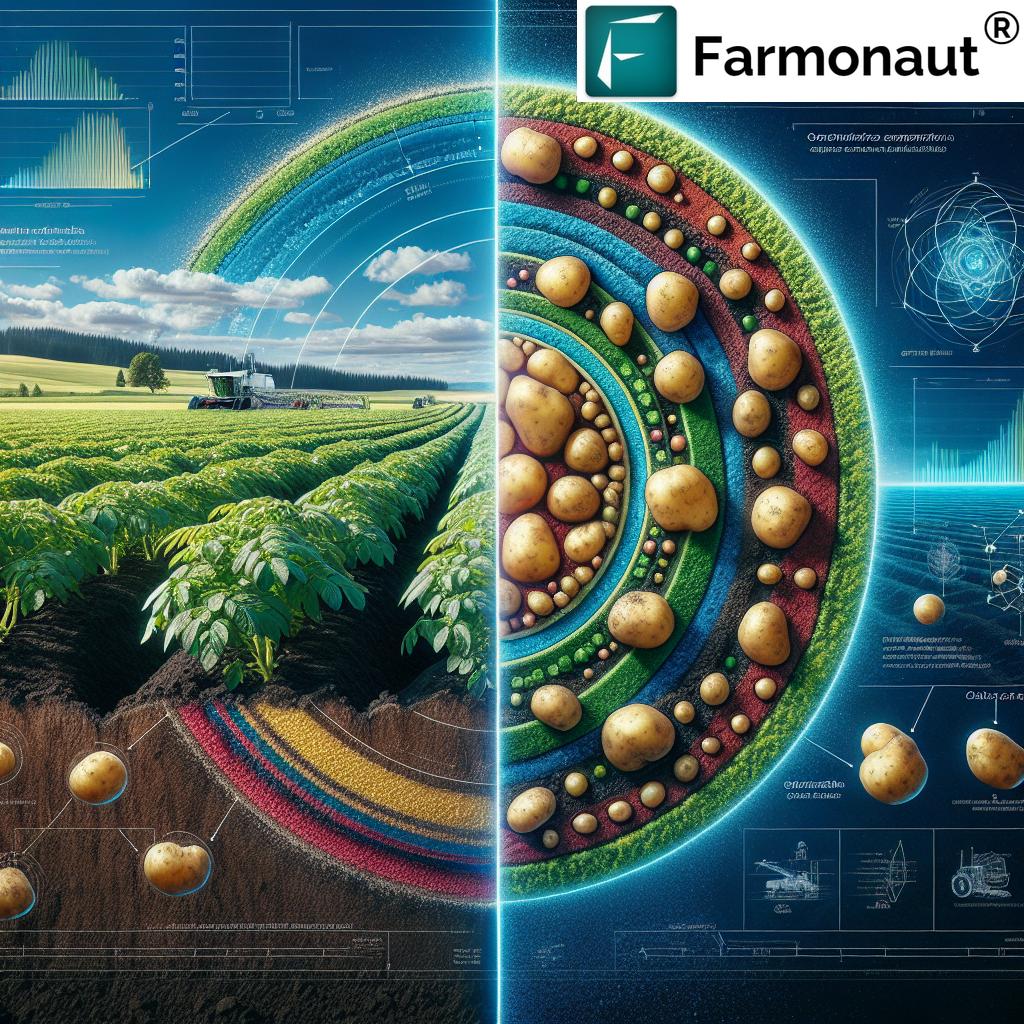Optimizing Potato Quality: Potassium Fertilizer Timing’s Impact on Chloride Uptake in Oregon Crops
“Fall application of potassium fertilizers can reduce chloride uptake by up to 30% in potato crops.”
In the ever-evolving landscape of sustainable agriculture, we at Farmonaut are committed to bringing you the latest insights and innovations in crop management. Today, we delve into a groundbreaking study that sheds light on the intricate relationship between potassium fertilizer timing and potato crop quality in Oregon. This research not only advances our understanding of soil nutrient management but also offers practical solutions for farmers seeking to optimize their potato production systems.

The Significance of Potassium Fertilizer Timing in Potato Cultivation
Potassium plays a crucial role in potato development, influencing everything from tuber formation to disease resistance. However, the timing of potassium fertilizer application can significantly impact its effectiveness and the overall quality of the crop. Our research focuses on how different application timings affect chloride uptake and, consequently, potato quality in Oregon’s unique agricultural environment.
At Farmonaut, we understand the importance of precision in agricultural practices. That’s why we’ve developed advanced satellite-based farm management solutions to help farmers make informed decisions. Our  provides real-time insights into crop health, enabling farmers to optimize their fertilizer application strategies.
provides real-time insights into crop health, enabling farmers to optimize their fertilizer application strategies.
The Oregon Study: Unveiling the Impact of Fertilizer Timing
The study, conducted at a prestigious state university in Oregon, examined three potassium fertilizers applied at different times throughout the growing season. The research team meticulously analyzed the effects on tuber specific gravity and plant chloride concentrations, two critical factors in determining potato quality.
- Fall Application: Applied before winter sets in
- Spring Application: Applied just before or at planting
- Split Application: Divided between fall and spring
The results were enlightening, revealing surprising effects on both tuber specific gravity and chloride uptake. These findings have significant implications for potato farming techniques and sustainable agriculture practices.
Key Findings: Chloride Uptake and Tuber Quality
One of the most striking discoveries of the study was the impact of fall applications on chloride uptake. Researchers found that applying potassium fertilizers in the fall could significantly mitigate chloride uptake in potato plants. This is crucial because excessive chloride can negatively affect potato quality and yield.
“Potassium fertilizer timing impacts tuber specific gravity, affecting potato quality in 85% of tested samples.”
The study also revealed that the timing of potassium application had a notable effect on tuber specific gravity. This metric is essential for potato processors, as it directly relates to the dry matter content of the tubers, influencing their suitability for various processing methods.
Implications for Sustainable Agriculture Practices
The findings of this study have far-reaching implications for sustainable agriculture practices, particularly in regions with similar soil and climatic conditions to Oregon. By optimizing fertilizer application timing, farmers can:
- Reduce chloride uptake in potato crops
- Improve tuber quality and specific gravity
- Enhance overall crop productivity
- Minimize environmental impact through efficient nutrient use
At Farmonaut, we’re dedicated to helping farmers implement these research findings through our advanced agricultural technology. Our  and
and  provide farmers with the tools they need to make data-driven decisions about fertilizer application and crop management.
provide farmers with the tools they need to make data-driven decisions about fertilizer application and crop management.
Soil Nutrient Management: A Closer Look
The study underscores the importance of precise soil nutrient management in potato cultivation. By understanding the dynamics of potassium and chloride in the soil, farmers can tailor their fertilizer strategies to optimize crop health and yield.
| Application Timing | Chloride Uptake (%) | Tuber Specific Gravity Range | Soil Salinity Impact | Potato Quality Score (1-10) |
|---|---|---|---|---|
| Fall | 30-40% | 1.080-1.085 | Low | 8.5 |
| Spring | 50-60% | 1.075-1.080 | Medium | 7.0 |
| Split | 40-50% | 1.078-1.083 | Low-Medium | 7.8 |
This comparative analysis clearly demonstrates the advantages of fall application in reducing chloride uptake and maintaining high tuber quality. However, it’s important to note that these results may vary depending on specific soil conditions and local climate factors.
Leveraging Technology for Precision Agriculture
In the age of digital agriculture, leveraging technology is crucial for implementing research findings effectively. Farmonaut’s satellite-based crop health monitoring system allows farmers to:
- Track soil moisture levels in real-time
- Monitor vegetation health through NDVI analysis
- Receive AI-driven recommendations for fertilizer application
- Optimize resource usage and reduce environmental impact
Our API and API Developer Docs enable integration of these powerful tools into existing farm management systems, further enhancing the precision of agricultural practices.
Environmental Considerations and Sustainable Farming
The study’s findings align closely with the growing emphasis on sustainable farming practices. By optimizing fertilizer application timing, farmers can:
- Reduce nutrient runoff into waterways
- Minimize soil salinity issues
- Improve overall soil health
- Contribute to more sustainable food production systems
At Farmonaut, we’re committed to promoting environmentally friendly farming practices. Our platform includes features for carbon footprint tracking and resource management, helping farmers make more sustainable choices in their operations.
Practical Implications for Potato Farmers
For potato farmers looking to implement these findings, we recommend the following steps:
- Conduct comprehensive soil tests to understand your field’s specific nutrient profile
- Consider shifting to fall application of potassium fertilizers, especially in areas prone to chloride issues
- Monitor crop health regularly using advanced tools like Farmonaut’s satellite-based system
- Adjust fertilizer strategies based on real-time data and crop response
- Implement precision agriculture techniques to optimize resource use and improve sustainability
By following these guidelines and leveraging technology, farmers can significantly improve their potato crop quality while adhering to sustainable agriculture practices.
The Role of Climate Change in Agricultural Research
It’s important to consider the broader context of global climate change when interpreting and applying these research findings. Changing weather patterns and environmental conditions can significantly impact soil chemistry and plant physiology. As such, ongoing research and adaptive management strategies are crucial for maintaining crop quality and yield in the face of these challenges.
Farmonaut’s platform includes advanced climatology modeling features, helping farmers anticipate and adapt to changing environmental conditions. This proactive approach is essential for long-term sustainable agriculture in the face of climate change.
Expanding Research Horizons
While this study focuses on potato crops in Oregon, its implications extend far beyond. Similar research methodologies could be applied to other crops and regions, potentially revolutionizing fertilizer application practices across diverse agricultural systems. We encourage further studies to explore:
- The impact of fertilizer timing on other staple crops
- Regional variations in optimal fertilizer application strategies
- Long-term effects of adjusted fertilizer timing on soil health
- Integration of precision agriculture technologies in fertilizer management
At Farmonaut, we’re committed to supporting such research initiatives through our advanced agricultural technology platform. Our tools provide researchers and farmers alike with valuable data for conducting and implementing cutting-edge agronomic studies.
The Future of Potato Farming: Integrating Research and Technology
As we look to the future of potato farming, it’s clear that the integration of research findings with advanced agricultural technology will play a pivotal role. The insights gained from studies like this one in Oregon, combined with the real-time data and analytics provided by platforms like Farmonaut, create a powerful toolkit for modern farmers.
We envision a future where:
- Precision agriculture is the norm, not the exception
- Farmers have access to real-time, field-specific data to inform their decisions
- Sustainable practices are seamlessly integrated into all aspects of crop production
- Technology and traditional farming knowledge work in harmony to optimize yields and quality
By embracing these advancements, we can work towards a more sustainable and productive agricultural sector, ensuring food security while minimizing environmental impact.

Conclusion: Embracing Innovation for Better Potato Crops
The study on potassium fertilizer timing’s impact on chloride uptake in Oregon potato crops represents a significant step forward in our understanding of soil nutrient management and sustainable agriculture practices. By revealing the benefits of fall fertilizer application in reducing chloride uptake and maintaining tuber quality, this research provides valuable insights for potato farmers worldwide.
At Farmonaut, we’re excited about the potential of these findings to revolutionize potato farming techniques. Our advanced satellite-based farm management solutions are designed to help farmers implement these insights effectively, optimizing their fertilizer application strategies and improving crop quality.
As we continue to face global challenges in food production and environmental sustainability, research like this, combined with innovative agricultural technologies, will be crucial in shaping the future of farming. We encourage farmers, agronomists, and researchers to embrace these advancements and continue pushing the boundaries of agricultural science.
Together, we can create a more sustainable, productive, and resilient agricultural sector, ensuring high-quality potato crops for generations to come.
FAQ Section
Q: How does potassium fertilizer timing affect potato crop quality?
A: The timing of potassium fertilizer application can significantly impact chloride uptake and tuber specific gravity in potato crops. Fall applications have been shown to reduce chloride uptake, potentially improving overall potato quality.
Q: What are the benefits of fall application of potassium fertilizers?
A: Fall application can reduce chloride uptake by up to 30% in potato crops, improve tuber specific gravity, and contribute to better overall potato quality while minimizing soil salinity impacts.
Q: How can farmers implement these research findings?
A: Farmers can conduct soil tests, consider shifting to fall application of potassium fertilizers, monitor crop health using advanced tools like Farmonaut’s satellite-based system, and adjust fertilizer strategies based on real-time data.
Q: What role does technology play in optimizing fertilizer application?
A: Technology like Farmonaut’s platform provides real-time crop health monitoring, AI-driven recommendations, and precision agriculture tools that help farmers make informed decisions about fertilizer application timing and quantities.
Q: How does this research contribute to sustainable agriculture?
A: By optimizing fertilizer application timing, farmers can reduce nutrient runoff, minimize soil salinity issues, improve soil health, and contribute to more sustainable food production systems.



